News
When our ancestors turned heads
Think of famous Egyptian royalty such as Cleopatra or Nefertiti or even African chieftains and what comes to mind is their regal bearing linked closely to the ornate and elegant head ornaments they wore. What of Sri Lanka? Harnessing his love for all that is reptilian, well-known herpetologist, Anslem de Silva, has more recently ventured not into murky waters but spent long hours studying documents and artefacts in the Colombo and Galle Museums and scrutinising and photographing the collections of traditional craftsmen living down South.
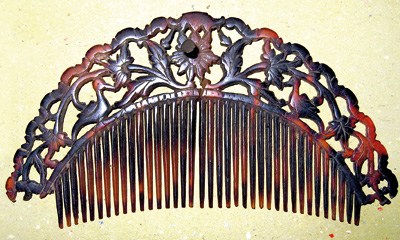
A woman’s half-moon shaped comb. (Courtesy: National Museums)
All to bring into focus the extraordinary head ornaments made of marine turtle shells sported not only by women but also men in the coastal areas of the country. Before using a fine-tooth comb to ferret out the head ornaments, Mr. de Silva in his research paper titled ‘Marine turtle-shell head ornaments of Sri Lanka’ published in the Journal of the Department of Wildlife Conservation, sets the backdrop.
Pointing out that humans have been using headdresses and ornaments for thousands of years, he says that some wore them as protection against the sun, rain or dew or as a symbol of royalty or high status. Others donned them during religious or ritualistic ceremonies; war or hunting; or just as a fashion statement.
Head ornaments were from various materials including metal (precious or semi-precious), bird-feathers, mammal skins, animal horn or scales, plant material or cloth, according to him. “In Sri Lanka, there is a profusion of granite sculptures in the ancient cities of Anuradhapura and Polonnaruwa and paintings such as the Sigiriya frescoes that depict intricate head-ornaments worn by both men and women,” he said.
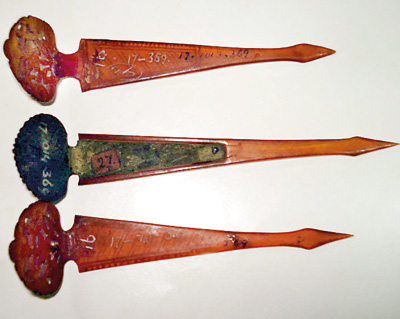
Women’s spoon-shaped hair-clips. (Courtesy: National Museums)
Then this herpetologist documents the head ornaments turned out from marine turtle scute, while setting the record straight about the widely used but erroneous term ‘tortoise shell’ in early literature. “These actually refer to the scute of the carapace or the upper shell of the hawksbill sea turtle (Eretmochelys imbricata),” he says.
He has found that there had been a thriving traditional marine turtle shell cottage industry for more than 2,000 years, with craftsmen and artisans turning out ornaments for local use and export. Quoting other literature, he points out how ambassadors from Sri Lanka went to Rome bearing gifts including ornamental scute turned out from hawksbill turtles.
Here are the three categories that Mr. de Silva picks out:
- The common horseshoe-shaped ‘bent’ head-comb (nemi panawa) and the ‘upright’ comb (kelin panawa) – together they were usually worn by men of high position in society or government in the southern or western coastal areas on special occasions until the early 1940s. Some upright combs were expensive as they were ornamented with gold or silver and inlaid with precious gemstones. Sometimes ordinary workers too wore simple bent combs.
- Hair pins and spoon-shaped hair clips worn by women.
- Half-moon shaped hair combs worn by women.
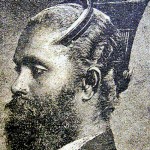
Man of high-standing wearing both the bent and upright combs. (Courtesy: Zaleski, 1887)
Referring to archaeological evidence, Mr. de Silva says that there is no proof of the use of head ornaments turned out from turtle scute in Sri Lanka before the Dutch period (1658 to 1796 ACE). However, he delves into earlier literature which indicates that the origin of upright combs is obscure, perhaps suggesting their use before the Dutch period through Malayan influence.
Mr. de Silva’s in-depth study of the subject has also uncovered two versions on the origins of wearing turtle scute head ornaments. According to records as early as 1840 and more recently as 1920, one version states that the head combs had initially been suggested by a Dutch Governor who observed that whenever a native chief took off his cap on entering his room, the long hair always fell over his face and shoulders.
The second version which differed drastically from the first, however, had been that the Sinhalese copied it from a Malay prince who was deported from Java to Sri Lanka by the Dutch around the 18th century. The Malays, in turn, are believed to have copied this adornment from the Javanese men who did not cut their hair and on particular occasions gathered it up and fastened it with semi-circular ‘tortoise-shell’ combs.
“The Malayan influence probably commenced even before the Dutch period,” states Mr. de Silva who quotes reports that during the reign of King Sena (833-853 ACE) friendly relations had existed between the Sinhalese and the Malays. He highlights several accounts of the use of turtle scute head ornaments which include Percival (1803) reporting how some Dutch women mixed with natives (probably Sinhalese) wore the hair in wreaths round the back of their heads with pins and plates of gold or turtle-shell half-moon shaped combs which compressed the hair and kept it firm at the back of their heads.
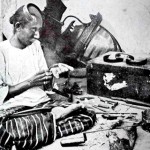
A turtle-shell artisan, himself wearing a bent comb, making similar combs. (Courtesy: Cave, 1908)
Cave (1908) has reported that the male population in the low country wore long hair twisted into a coil at the back of the head and a horse-shoe shaped turtle comb at the top…………that men of humble position went for combs of finest lustre and perfect manufacture, while men of higher social position wore additional higher combs which were of considerable height above their glossy coils at the back of the heads.
Insights have also been provided by these writers of yore on the brutal methods of removing the scute from the live animal, with Cave stating that shells obtained from the claws (perhaps the marginals) and fused together were greatly prized by the comb-wearing Sinhalese.
On why the use of these head ornaments would have declined, Mr. de Silva says that the contributory factors possibly were a decline in the wild populations of the hawksbill turtle, imposition of wildlife protection laws which covered marine turtles and banned the sale of turtle products and a decline in the tradition of most men having long hair by the mid-1900s.
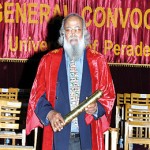 Anslem de Silva at the Peradeniya Convocation Anslem Conferred doctorate at Pera convocation | |

